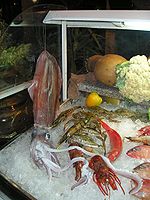- Cold chain
-
Food safety 
Terms Foodborne illness Hazard Analysis and Critical Control Points (HACCP) Critical control point Critical factors Food, acidity, time, temperature, oxygen and moisture pH Water activity (aw) Pathogens Clostridium botulinum E. coli Hepatitis A Norovirus Parasitic infections Blastocystis Cryptosporidiosis Trichinosis  Vaccines are temperature controlled until use
Vaccines are temperature controlled until use Slurry ice used to ship sensitive food products
Slurry ice used to ship sensitive food products Iced seafood on display
Iced seafood on display
A cold chain is a temperature-controlled supply chain. An unbroken cold chain is an uninterrupted series of storage and distribution activities which maintain a given temperature range. It is used to help extend and ensure the shelf life of products such as fresh agricultural produce,[1] frozen food, photographic film, chemicals and pharmaceutical drugs.[2]
Contents
Uses
Cold chains are common in the food and pharmaceutical industries and also some chemical shipments. One common temperature range for a cold chain in pharmaceutical industries is 2 to 8 °C. but the specific temperature (and time at temperature) tolerances depend on the actual product being shipped.
This is important in the supply of vaccines to distant clinics in hot climates served by poorly developed transport networks. Disruption of a cold chain due to war may produce consequences similar to the Smallpox outbreaks in the Philippines during the Spanish-American war.[citation needed]
Traditionally all historical stability data developed for vaccines was based on the temperature range of 2-8 °C. With recent development of biological products by former vaccine developers, biologics has fallen into the same category of storage at 2-8 °C due to the nature of the products and the lack of testing these products at wider storage conditions.
The cold chain distribution process is an extension of the good manufacturing practice (GMP) environment that all drugs and biological products are required to adhere to, enforced by the various health regulatory bodies. As such, the distribution process must be validated to ensure that there is no negative impact to the safety, efficacy or quality of the drug substance. The GMP environment requires that all processes that might impact the safety, efficacy or quality of the drug substance must be validated, including storage and distribution of the drug substance.
Validation
A cold chain can be managed by a quality management system. It should be analyzed, measured, controlled, documented, and validated.
The food industry uses the process of Hazard Analysis and Critical Control Point, HACCP, as a useful tool. Its usage continues into other fields. PDA (Parenteral Drug Association) Technical Report # 39 gives a rough summary of how the cold chain can be validated.
The overall approach to validation of a distribution process is by building more and more qualifications on top of each other to get to a validated state. This is done by executing a Component Qualification on the packaging components. Next, an Operational Qualification that demonstrates the process performs at the operational extremes. The final piece is the Performance Qualification that demonstrates that what happens in the real world is within the limits of what was demonstrated in the Operational Qualification limits.
The PDA's Technical Report states that a Component Qualification is required to demonstrate that a component can be manufactured to the design criteria of that individual component. This was put into the document because the industry did not understand the principles of Validation; all Validation processes were specific to equipment and not auxiliary processes such as shipping/distribution.
Performing thermal testing can also help with validating the cold chain. Certified test labs use environmental chambers to simulate ambient profiles that a package may encounter in the distribution cycle. Thermocouple probes and separate temperature dataloggers measure temperatures within the product load to determine the response of the package to the test conditions. Replicate testing based on a qualification protocols is used to create a final qualification report that can be used to defend the configuration when audited by regulators. It is normally best to have an individual that understands the principles of Validation, when defending such processes to a Federal Regulatory body of any nation.
Cold chains need to be evaluated and controlled:
- Carriers and logistics providers can assist shippers. These providers have the technical ability to link with airlines for real time status, generate web-based export documentation and provide electronic tracking.
- The use of refrigerator trucks, refrigerator cars, reefer ships, reefer containers, and refrigerated warehouses is common.
- Shipment in insulated shipping containers or other specialised packaging.[3]
- Temperature data loggers and RFID tags help monitor the temperature history of the truck, warehouse, etc. and the temperature history of the product being shipped.[4] They also can help determine the remaining shelf life.[5]
- Documentation is critical. Each step of the custody chain needs to follow established protocols and to maintain proper records. Customs delays occur due to inaccurate or incomplete customs paperwork, so basic guidelines for creating a commercial invoice should be followed to ensure the proper verbiage, number of copies, and other details.
During the distribution process one should monitor that process until one builds a sufficient data set that clearly demonstrates the process is in compliance and in a state of control. Each time the process does not conform to the process, the event should be properly documented, investigated and corrected so that the temperature excursion do not occur on future shipments. Thus the process is continually evolving and correcting for anomalies that occur in the process. Eventually the process can evolve into periodic monitoring once sufficient data demonstrates that the process is in a state of control. Any anomaly that occurs once a process is in a state of control will result in the process being invalidated and not in control and result in product withdraw from the market to ensure patient safety.
It is necessary to develop an internal documentation system as well as multi-party communication standards and protocols to transfer or create a central repository or hub to track information across the supply chain. These systems would monitor equipment status, product temperature history, and custody chain, etc. These help ensure that a food, pharmaceutical, or vaccine is safe and effective when reaching its intended consumer.
See also
- Bacterial growth
- Cool Chain Quality Indicator (CCQI)
- HACCP
- Insulated shipping container
- Logistics
- Packaging
- Shelf life
- Specification
- Temperature control
- Time temperature indicator
- Thermal decomposition
- Thermal insulation
- Tolerance (engineering)
- Transportation management system
- United States Pharmacopeia
- Validation (drug manufacture)
- Verification and validation
Notes
- ^ Kohli, Pawanexh. "Fruits and Vegetables Post-Harvest Care: The Basics" (PDF). Crosstree Techno-visors. http://crosstree.info/Documents/Care%20of%20F%20n%20V.pdf.
- ^ Gyesley, S. W. (1991). Total Sysstems Approach to Predict Shelf Life of Packaged Foods. ASTM STP 1113-EB.
- ^ Singh, S. P.; Burgess, Singh (January 2008). "Performance comparison of thermal insulated packaging boxes, bags and refrigerants for single-parcel shipments". Packaging Technology and Science 21 (1): 25–35. doi:10.1002/pts.747.
- ^ Riva, Marco; Piergiovanni, Schiraldi, Luciano; Schiraldi, Alberto (January 2001). "Performances of time-temperature indicators in the study of temperature exposure of packaged fresh foods". Packaging Technology and Science 14 (1): 1–39. doi:10.1002/pts.521.
- ^ Meyers, T (June 2007). "RFID Shelf-life Monitoring Helps Resolve Disputes". RFID Journal. http://www.rfidjournal.com/article/articleview/3357/1/128/.
Further reading
- Protecting Perishable Foods During Transport by Truck, USDA Handbook 669, 1995, [1]
- "Manual on the Management, Maintenance and Use of Blood Cold Chain Equipment", World Health Organization, 2005, ISBN 9241546735
- Pawanexh Kohli, "Fruits and Vegetables Post-Harvest Care: The Basics", Explains why the cold chain is required for fruits and vegetables.
- Clive, D., "Cold and Chilled Storage Technology", 1997, ISBN 0751403911
- EN 12830:1999 Temperature recorders for the transport, storage and distribution of chilled, frozen and deep-frozen/quick-frozen food and ice cream
- Ray Cowland, Developing ISTA Cold Chain Environmental Standards, 2007.
Food preservation Biopreservation · Canning · Cold chain · Curing · Drying · Fermentation · Freezing · Freeze drying · Hurdle technology · Irradiation · Jamming · Jellying · Jugging · Modified atmosphere · Pickling · Potting · Pressure · Salting · Smoking · Sugaring · Vacuum packingCategories:
Wikimedia Foundation. 2010.



